Inhale, Exhale: Cigarettes and the Power of Michael Corleone
By Meaghan Allen
Few people smoke in Coppola’s The Godfather, and for many of those who do, the cigarette functions more as a prop than as an expression of an idea about their character. However, the moments that Michael Corleone, played by Al Pacino, chooses to smoke are exceptional, deliberate moments: the action is in fact an action and not something done absent-mindedly. Michael smokes his cigarettes with purpose, as an image of his authority—of his emotional and mental strength as Godfather-in-the-making.
The choice of a cigarette to represent Michael’s symbolic power is significant because a cigarette is not a latent, or concealed, object: it consumes; it burns; it has the potential to kill and destroy. It is a piece of death that fits between the fingers and is kissed as the smoker inhales its substance, filling the body with fire. A cigarette demands a certain sense of control and presence, and—when used consciously—can be evocative of raw force.
The subtle symbolism of cigarettes is developed especially across three scenes in The Godfather: the scene where Michael comes home after Vito has been shot; the scene where Michael stands guard for his father outside the hospital; and the scene in which Michael is officially named Don. Whether through Michael’s physical movements (in particular his handling of cigarettes and lighters) or through the visual composition of the scene’s frame, Coppola underscores that, for Michael, the cigarette serves as a totem of dominance, control, and cool authority.
***
In the scene where the Family deliberates after the shooting of Vito, we see five men sitting in the dark office of the Corleone home. The shot is a medium ensemble shot of Michael (his back to the camera), Tom Hagen (profile), Sonny (almost direct center), Clemenza (3/4 face viewable), and Tessio (most of his face obscured, so we see mainly the back of his head). The camera is located behind the Don’s table, in line with the perspective of someone sitting in the leather chair, an evocation of Vito’s presence despite his being in the hospital. Out of focus in the foreground are a few objects sitting on the table, elements of the mise-en-scene: a cup, a small business ledger, some unidentifiable (due to the shadows) desk trinkets, and a pack of cigarettes.
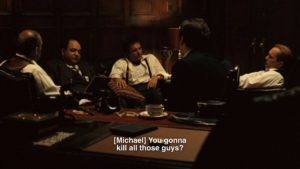
The men are all talking, discussing how to proceed given the news that Sollozzo has nearly succeeded in murdering Vito. In the whirling current of the conversation, Michael—who has been silent—comments, “You gonna kill all those guys” (referring to Sollozzo, Barzini, Tattaglia), and Sonny barks back, “Hey Mikey stay out of it!” This abrupt response silences Michael, and his lack of voice is tangible, a void in the overlapping whir of conversation. A beat later, though, he turns his head, and his face is now in profile. He turns his head further, giving the camera a full view of his face, and looks on the desk, possibly for some hint of encouragement from his missing father, to find his voice: he sees the pack of cigarettes. Michael gets out of his chair, walks very briefly out of the frame, and then re-enters in the foreground to grab a cigarette from the pack, which he tosses haphazardly back onto the table. He is now located in the dark shadows at the edge of the frame, his body a shapeless mass that morphs into the limits of the shot, becoming one with the shadows, not only of the scene but of the shadowy criminal underworld.
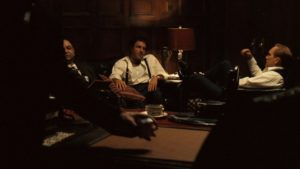
He is standing, meaning that the others must look up at him when they speak. Sonny points to Michael, says something incomprehensible regarding “Do me a favor” (which loosely recalls the opening scene between Vito [Michael] and Bonasera [Sonny] who comes to the Godfather for a ‘favor’)—a comment to which Michael does not respond verbally. Instead he moves back to his chair and sits, the cigarette firmly between his lips. In a few calculated movements Michael has not only foreshadowed his readiness to enter the family business by becoming one with the shadows of the frame and room, but he has also taken charge of the shot by seeking his emblematic cigarette.
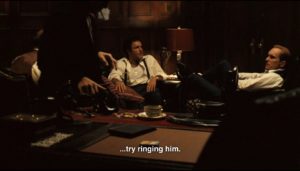
In the composition of the medium ensemble shot, Sonny appears to be the focus, as the man in power, and Michael is presented as occupying a subordinate position, with his back to the camera. But by moving in the frame, coming closer to the camera, and therefore becoming a larger, more dominant presence, Michael has become the center of attention. He is now the man in power. Sonny may still be handling the logistics of business as the perceived head of the family, but Michael is the interesting, active presence. He captures the camera’s gaze, and he does so to light a cigarette.
This cigarette is not any mere cigarette: it is Michael’s first cigarette in the film, and it was presumably Vito’s as it was on his desk. This cigarette, this token of strength and leadership, comes from the reigning head of the family. Even if the cigarette was not originally Vito’s, it is coming from a place of power by being in the office, on the Don’s desk. When it enters Michael’s mouth and he inhales the essence of the cigarette and has it fill his body, it endows him with metaphorical authority.
***
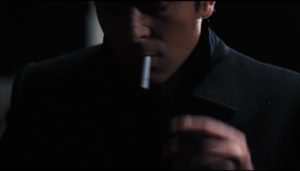
The symbolic power of this cigarette carries over and is heightened in the next significant cigarette scene, which occurs between Enzo, the baker, and Michael outside the hospital later that night. Enzo’s hands are shaking uncontrollably as he reaches into his coat pocket for his pack of smokes. He and Michael have just successfully deferred an attack on Don Corleone, who has been shot and is recovering in the hospital, by standing out by the front gate of the hospital posing as armed body guards. The close-up shot pans from Enzo’s hands retrieving a cigarette up towards his face, the camera gracefully following the movement of his hands. The further towards his mouth his hand moves, the more violently he begins to shake in intense spasms. He turns his face away to scan his surroundings in an attempt to collect his bearings; the clicking of the lighter as he struggles to strike it can be heard.
We cut to a close-up of Enzo’s hand unsuccessfully igniting the lighter; he fumbles repeatedly, unable to control his hand muscles enough to turn the flint wheel and strike the flame. Michael’s hands then reach into the frame. The camera subtly follows Michael’s hands as they successfully turn the flint wheel on the first attempt and a strong flame flares. The frame holds, and Enzo leans down into Michael’s hands to light his cigarette. As Enzo pulls out of the frame, the camera angle cuts towards a medium close-up of Enzo and Michael, the focus of the shot now on Michael: he is looking down at his hands with intense concentration, his face enveloped in the smoke exhaled by Enzo’s cigarette. We then cut to a close up of Michael’s hands still holding the lighter, the lid still up; he pauses, briefly, before snapping the lid shut as police sirens enter the soundscape.
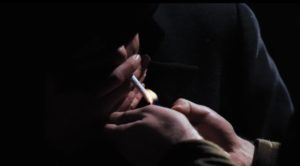
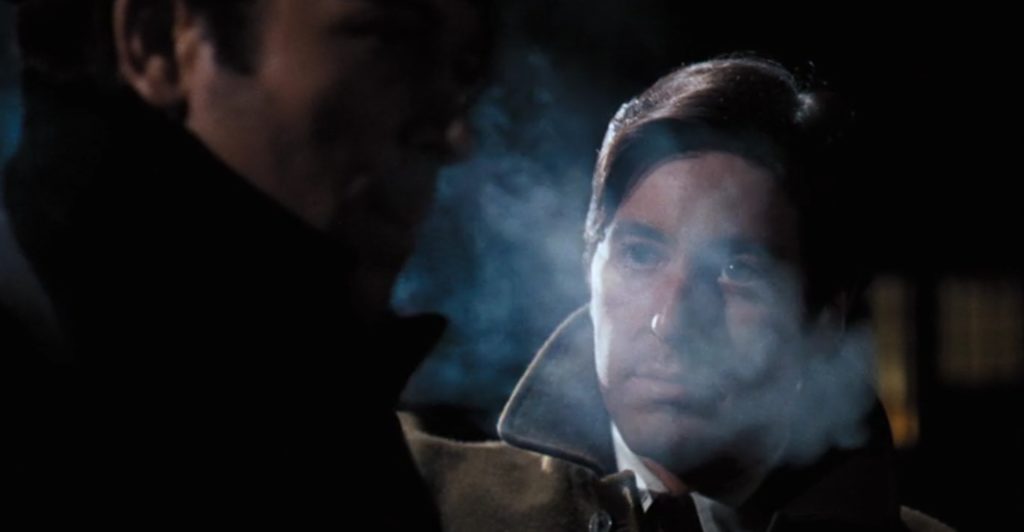
There is a lot going on in this particular encounter, one that lasts only twenty seconds of an almost three-hour film. What is revealed about Michael’s character is crucial. This scene outside the hospital occurs immediately after Michael pledges his allegiance to his father and by implication the family, declaring at Vito’s bedside that he is finally ‘with’ them. Michael has now officially entered the criminal underworld, posing as an armed mafioso, and he has done so with grace and courage. Despite the high risk and tension of a difficult situation he maintains his composure.
The juxtaposition of Enzo’s shaking hands with Michael’s steady hands underlines that Michael is capable of staying rational, calm, collected, and cool in this monstrous syndicate. He is in full control of his emotions, thoughts, and actions—embodying a composure that is absolutely necessary if he wishes to follow in his father’s footsteps and become Don. Also noteworthy is the choreography of power expressed by the gestures: Enzo bends down to light his cigarette, but Michael does not move his hands towards Enzo’s face. Michael is the provider of light, sustenance, and protection; Enzo merely receives these gifts.
The source of these gifts, a lighter, also carries a great deal of symbolic resonance. A lighter is an object capable of complete destruction: it has the capacity to burn all obstacles that stand in the way, and it furnishes fuel for the totemic cigarettes that Michael smokes. This small, sleek item, unassuming in its power, might be said to find a parallel in the character of Michael—the decorated war veteran, the ‘good kid’ who becomes the meticulous, cold-blooded, murderous Godfather by the end of the film. The lighter and its essential companion the cigarette have begun to function, then, as a cinematic trope expressing Michael’s control as Don, his observant nature, and his ability to destroy and be the hand of death. In short, they suggest his complete patriarchal (possibly phallic) power as Godfather.
***
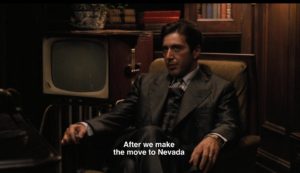
The final compelling scene of Michael’s smoking occurs at a transitional moment in his rise as Godfather, when Vito first places Michael in charge. In this scene, which again occurs in the family office, the shot switches from a brief ensemble shot of Michael sitting beneath the lamp, the only source of light in the shuttered room, to a medium shot of Michael in his chair. His legs are crossed and he is twirling his lighter in his hand as he talks of moving the family’s business to Nevada. He is in a suit (wearing the same tie he does at the baptism), and his body is active, his fingers lightly tapping the lighter and his crossed leg restlessly bouncing. His authority as Don is not being taken seriously – Clemenza and Tessio keep turning to Vito, not Michael, for instruction. It is not until after the brief dialogue between Vito, Clemenza, and Tessio, where Vito declares “Be a friend to Michael,” that Michael’s dominion as Don takes hold.
This absolute reign begins when the shot again becomes a medium ensemble and Michael ascends from his chair beneath the light to stand assertively behind the Don’s desk. As he takes his place, it is clear that he now has a lit cigarette in his hand. His voice is more confident and demanding, and he not only has physical power over Clemenza and Tessio (who are now sitting below him), but he also has his token of authority securely between his two fingers. Michael begins to hand down a series of authoritative decisions.
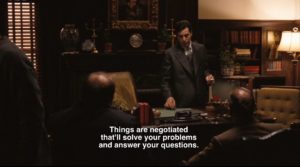
The film cuts to a middle shot of Carlo as it is revealed he will be in charge in Nevada; it cuts to a middle shot of Tom, who will no longer be consigliere but instead the family lawyer in Nevada (the shot lingers to gauge Tom’s reaction); then we cut to a medium close-up shot of Michael, who is still standing. The cigarette has moved out of the frame but the smoke can be seen languidly drifting up—a reminder that it is still there, burning away, mixing in the air that Michael inhales to speak. The smoke mimics Michael’s thoughts and actions, curling and twisting like his soul as he adapts to the complex situations presented throughout the film.
Michael’s hands do not shake as he holds a thread of death in them, the ability to destroy and conquer evoked by a single image: the cigarette. Its source of power, the lighter, a small compact brass box, has the ability to burn and consume everything that gets in its way; it is a portable inferno of judgment—not so far from Michael during the infamous baptism sequence.
***
While these three scenes suggest the arc of Michael’s development via his handling of cigarettes, cigarettes are Michael’s companion and totem in three other scenes too. In the anticipation of ‘the meet’ with Sollozzo, Michael gently places a cigarette between his lips in the family kitchen to keep his calm while Sonny and Tom get anxious; when Mo Green challenges Michael in Las Vegas, Michael lights a cigarette as he prepares to tell Mo how things should be, simultaneously twirling his lighter as he does so (possibly alluding to Mo’s eventual death); and finally, Michael lights two cigarettes in the last scene of the film after Connie accuses him of murdering Carlo and Kay earnestly presses him on whether he had Carlo killed. He lights up, first, when he is giving her his ‘one-time-only’ answer about the true nature of his business; and he lights up again when he is framed by the door as Kay prepares drinks in the foreground and members of the family filter into his office.
For Michael, smoking allows for a form of meditation and deliberation that is also at the heart of his newfound power. Through the methodical rhythm of inhalation and exhalation, he achieves a cool control that becomes the personal signature of his brand of dominance. Held gently but confidently between the two fingers of Michael’s hand, the cigarette claims its place in the hands of the Godfather whose hands do not shake, the man who does not allow the strings of the family business to tangle. Michael is the one who holds the strings taut and with care, all the while enveloped in the drifting smoke of power.

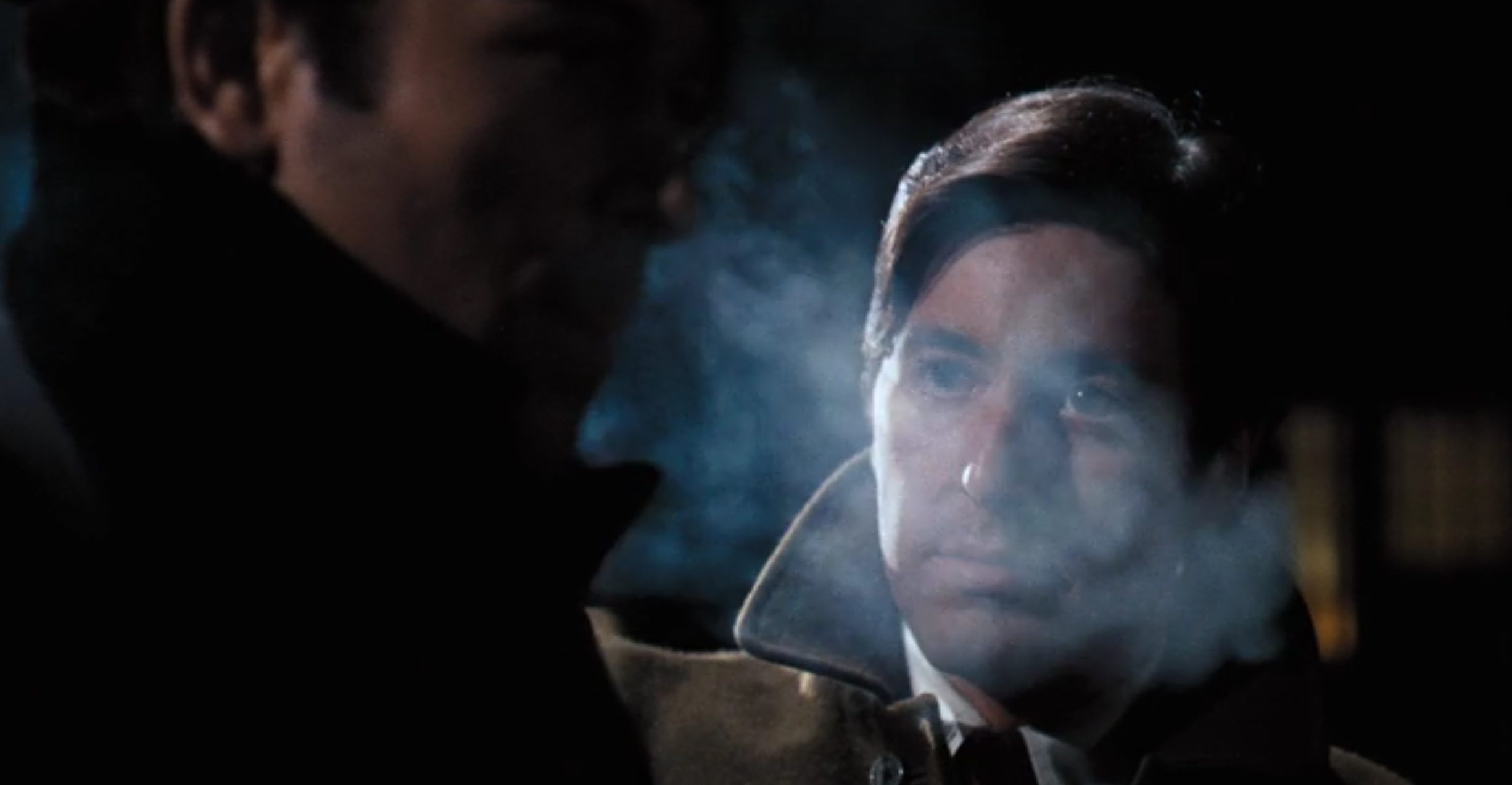
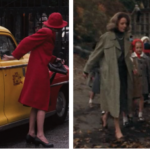
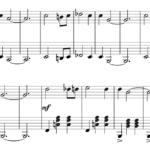

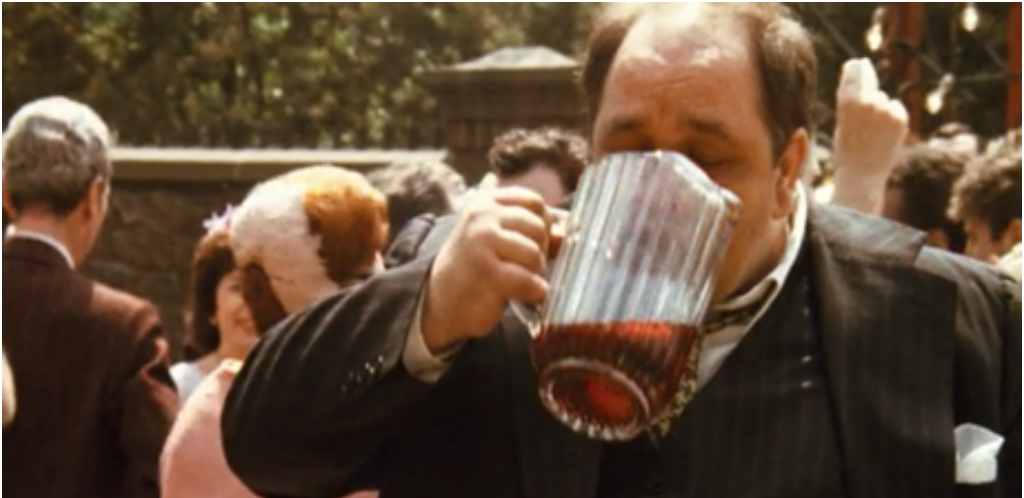
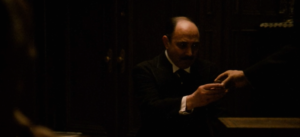
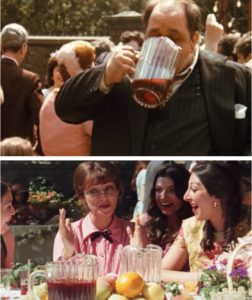
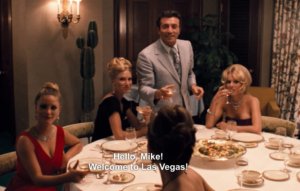
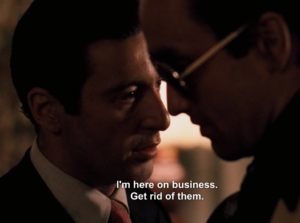

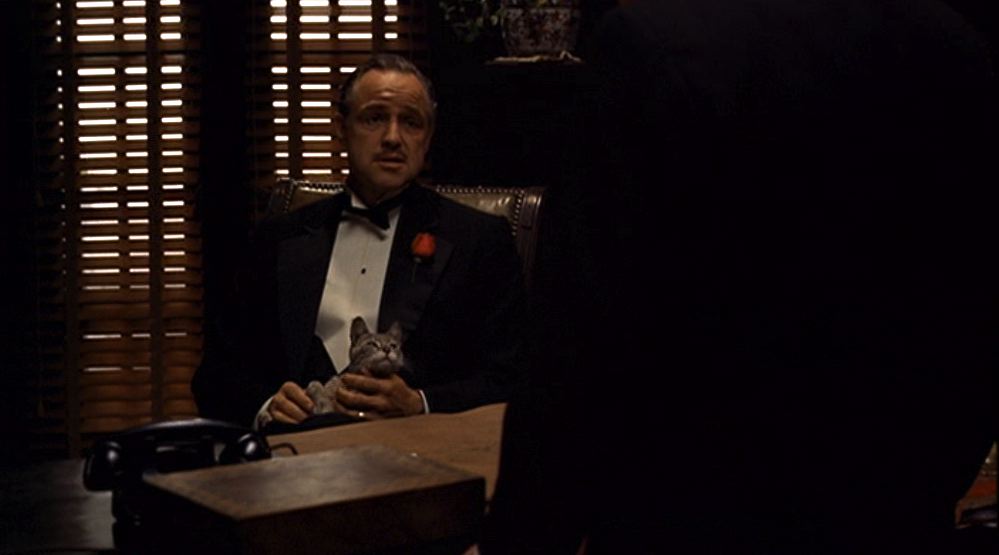
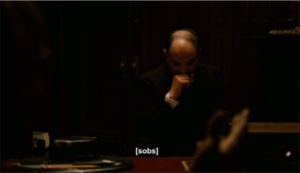
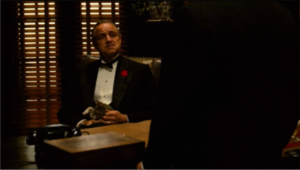
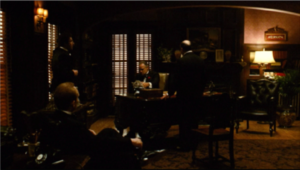
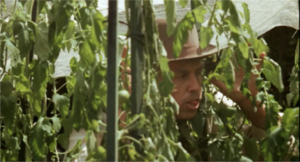

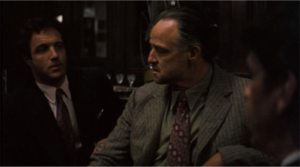
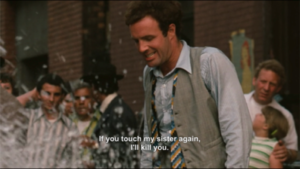
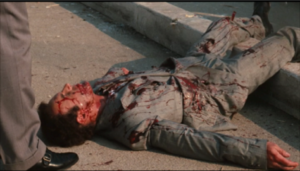
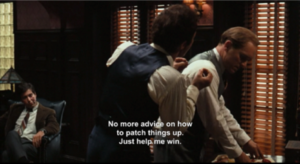
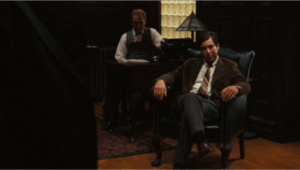
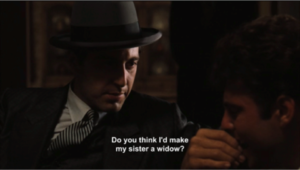
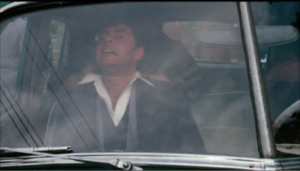
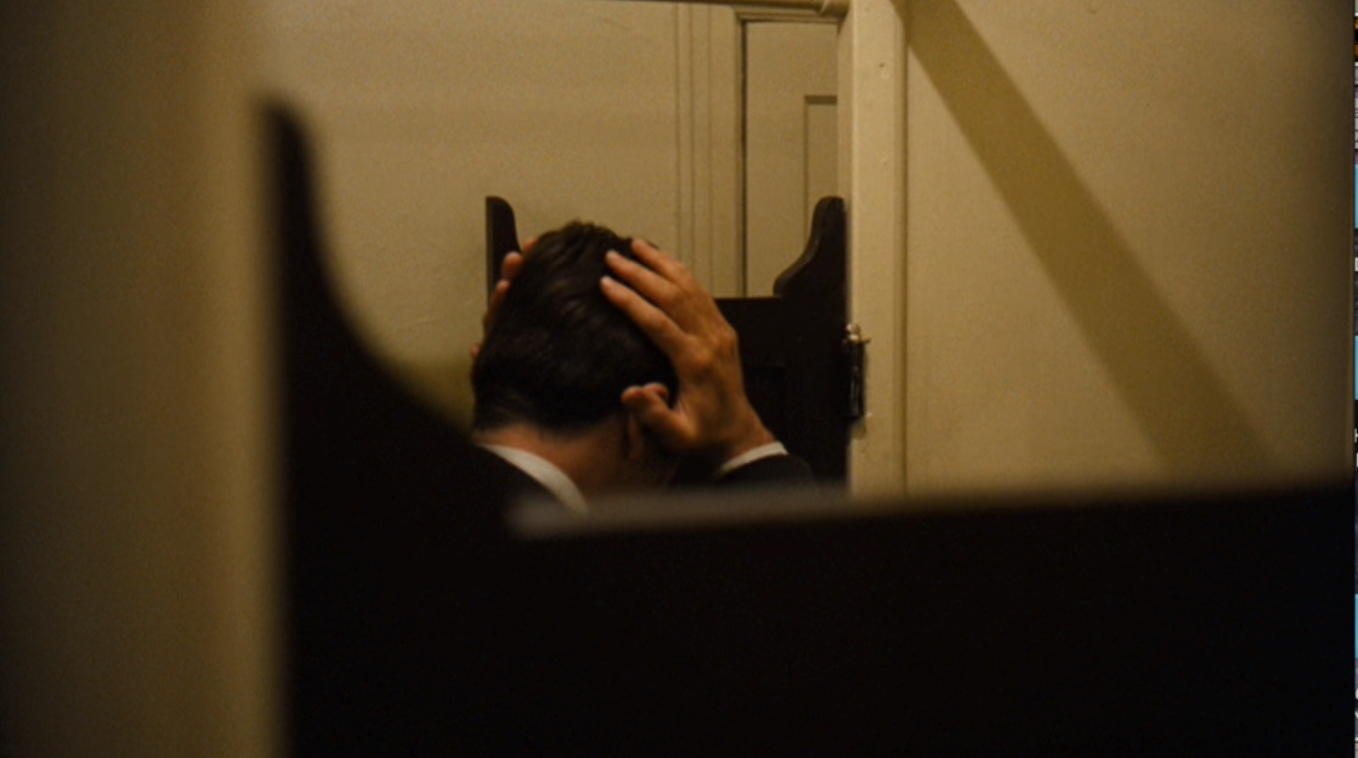

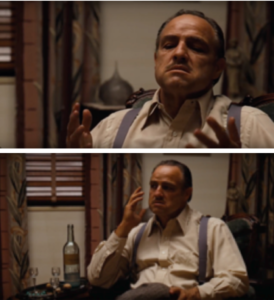 As the head of the Family, Vito is not stripped of his patriarchal position when he sits down. Rather, his status is elevated: he is a king upon his throne. With all eyes drawn toward him, he is careful to use limited and deliberate physical gestures to conceal his thoughts and emotions. When Tom Hagen briefs Vito about Sollozzo’s request to receive protection in exchange for a percentage of the profits of his drug trade, Vito sits with his legs crossed while reclining in his seat. Before the meeting with Sollozzo commences, Vito nods his head, shrugs his shoulders, and sways—as if he were doing Sollozzo a favor by indulging his offer, only bestowing the minimum physical attention required to hear his request. He also asks Tom if he is “not too tired,” as if to suggest his own fatigue as the Don. His body language reveals a disinclination towards stretching the reach of the Family business, as it jeopardizes the familial affiliations that he has established within and outside his blood ties. When Sonny asks him what his decision is going to be, Vito raises his hand from his cheek before resting it on his chin, withholding his thoughts until the next scene.
As the head of the Family, Vito is not stripped of his patriarchal position when he sits down. Rather, his status is elevated: he is a king upon his throne. With all eyes drawn toward him, he is careful to use limited and deliberate physical gestures to conceal his thoughts and emotions. When Tom Hagen briefs Vito about Sollozzo’s request to receive protection in exchange for a percentage of the profits of his drug trade, Vito sits with his legs crossed while reclining in his seat. Before the meeting with Sollozzo commences, Vito nods his head, shrugs his shoulders, and sways—as if he were doing Sollozzo a favor by indulging his offer, only bestowing the minimum physical attention required to hear his request. He also asks Tom if he is “not too tired,” as if to suggest his own fatigue as the Don. His body language reveals a disinclination towards stretching the reach of the Family business, as it jeopardizes the familial affiliations that he has established within and outside his blood ties. When Sonny asks him what his decision is going to be, Vito raises his hand from his cheek before resting it on his chin, withholding his thoughts until the next scene.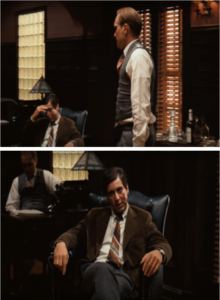 After he inherits Vito’s throne, Michael’s sitting posture recalls his father’s — but with some striking differences. When Michael offers a plan to exact retribution for his father’s shooting, he positions himself in an armchair in a similar manner to his father, crossing his legs and lolling in the furniture. However, Michael is not as calm and collected as Vito had been: he rubs his eyebrows and slumps in his chair, moving his body back and forth before proceeding with his plan. He’s restless—sweaty and squirming. He wants to take immediate action, but he does not act upon his impulses. In the following moments, he places both arms on the handles of the chair as a way to ground himself within the turbulence. As the camera zooms in, Michael’s body becomes more relaxed while still tilting forward: we sense that he is more comfortable with his position, prepared to prove his power. He slurs his words, recalling how his father often mumbles his words, but he does so in anger, his gestures intensified by the sternness of his stare and speech.
After he inherits Vito’s throne, Michael’s sitting posture recalls his father’s — but with some striking differences. When Michael offers a plan to exact retribution for his father’s shooting, he positions himself in an armchair in a similar manner to his father, crossing his legs and lolling in the furniture. However, Michael is not as calm and collected as Vito had been: he rubs his eyebrows and slumps in his chair, moving his body back and forth before proceeding with his plan. He’s restless—sweaty and squirming. He wants to take immediate action, but he does not act upon his impulses. In the following moments, he places both arms on the handles of the chair as a way to ground himself within the turbulence. As the camera zooms in, Michael’s body becomes more relaxed while still tilting forward: we sense that he is more comfortable with his position, prepared to prove his power. He slurs his words, recalling how his father often mumbles his words, but he does so in anger, his gestures intensified by the sternness of his stare and speech.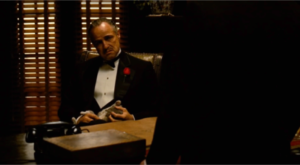 Vito and Michael both use hand movements that reveal them suppressing their anger and frustration. In the opening scene, mortician Amerigo Bonasera offers to pay Vito Corleone in exchange for revenge upon the men who abused his daughter—an offer which offends the Don, as it insinuates he is both a killer and can be “bought.” Prior to this exact moment, Vito’s hand is petting and playing with a cat sitting on his lap; just after, his grip tightens around the animal’s head. The sequence of gestures suggests a few meanings: (1) he is crushing his urge to act upon his anger towards Amerigo Bonasera—he is a man, “not a murderer”—which would demonstrate a childish weakness that cannot be associated with the patriarch of a family, let alone the Family; and (2) given that the image of a cat often carries both feminine and sexual connotations, Vito’s intensifying hold shows him flexing his masculine power and exerting his dominance, his full control.
Vito and Michael both use hand movements that reveal them suppressing their anger and frustration. In the opening scene, mortician Amerigo Bonasera offers to pay Vito Corleone in exchange for revenge upon the men who abused his daughter—an offer which offends the Don, as it insinuates he is both a killer and can be “bought.” Prior to this exact moment, Vito’s hand is petting and playing with a cat sitting on his lap; just after, his grip tightens around the animal’s head. The sequence of gestures suggests a few meanings: (1) he is crushing his urge to act upon his anger towards Amerigo Bonasera—he is a man, “not a murderer”—which would demonstrate a childish weakness that cannot be associated with the patriarch of a family, let alone the Family; and (2) given that the image of a cat often carries both feminine and sexual connotations, Vito’s intensifying hold shows him flexing his masculine power and exerting his dominance, his full control.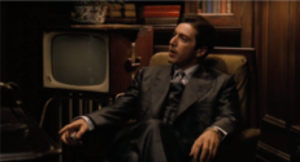 Michael, on the other hand, is less composed and constrained in his physical mannerisms—his body is seemingly riddled with anxiety. After Michael’s return from Sicily, he makes significant decisions as the new “head of the Family,” including relocating the business transactions to Las Vegas and replacing Tom Hagen as consigliere. During this scene, Michael is twiddling a zippo lighter between his fingers, smoking a cigarette, and prolongedly pressing it into an ashtray.
Michael, on the other hand, is less composed and constrained in his physical mannerisms—his body is seemingly riddled with anxiety. After Michael’s return from Sicily, he makes significant decisions as the new “head of the Family,” including relocating the business transactions to Las Vegas and replacing Tom Hagen as consigliere. During this scene, Michael is twiddling a zippo lighter between his fingers, smoking a cigarette, and prolongedly pressing it into an ashtray.
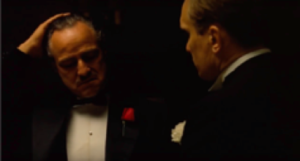 After the opening scene, Don Vito runs a hand against his grey, slicked-backed hair and qualifies his terms for the mortician’s debt: “We’re not murderers, despite what this undertaker says.” In this scene, Vito is literally scratching his head at his decision to expand the scope of the Family to meet the pleas of an acquaintance who has deliberately avoided them. Yet Vito’s grooming habit is second nature to him—he stays in character as the cool and collected Don.
After the opening scene, Don Vito runs a hand against his grey, slicked-backed hair and qualifies his terms for the mortician’s debt: “We’re not murderers, despite what this undertaker says.” In this scene, Vito is literally scratching his head at his decision to expand the scope of the Family to meet the pleas of an acquaintance who has deliberately avoided them. Yet Vito’s grooming habit is second nature to him—he stays in character as the cool and collected Don.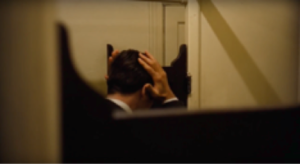 This gesture is replayed in a different key in the pivotal scene at the Italian restaurant, in which Michael struggles to carry out the plot he proposed—to kill Sollozzo and his police guard. Just after he retrieves the gun from the restaurant’s toilet, Michael stands in front of the bathroom’s mirror and presses both hands against his hair in an attempt to gather himself. Here, Michael is on the edge of becoming a part of the family — a family that he had pointedly described, to his girlfriend Kay, as “not me”. His fingers are pushed against his head—he is trying to wrap his brain around his decision. By executing his plan, he not only will be initiated into the business, but also will finally be able to feel like a part of the Corleone family by embodying the role of his father. With the gun concealed in his jacket, Michael seats himself at the table with Sollozzo and his police guard; he brushes his hair back and switches from speaking in Italian to English when staking his claim: “What’s most important to me is that I have a guarantee: no more attempts on my father’s life.” By protecting the patriarch, Michael secures his succession.
This gesture is replayed in a different key in the pivotal scene at the Italian restaurant, in which Michael struggles to carry out the plot he proposed—to kill Sollozzo and his police guard. Just after he retrieves the gun from the restaurant’s toilet, Michael stands in front of the bathroom’s mirror and presses both hands against his hair in an attempt to gather himself. Here, Michael is on the edge of becoming a part of the family — a family that he had pointedly described, to his girlfriend Kay, as “not me”. His fingers are pushed against his head—he is trying to wrap his brain around his decision. By executing his plan, he not only will be initiated into the business, but also will finally be able to feel like a part of the Corleone family by embodying the role of his father. With the gun concealed in his jacket, Michael seats himself at the table with Sollozzo and his police guard; he brushes his hair back and switches from speaking in Italian to English when staking his claim: “What’s most important to me is that I have a guarantee: no more attempts on my father’s life.” By protecting the patriarch, Michael secures his succession.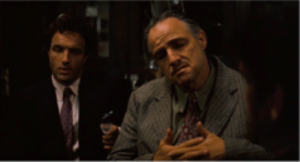 When Vito meets with Sollozzo to listen to his proposition (only to decline), his blazer is unbuttoned, and he droops one arm over the chair while the other dangles from his hip. Vito gives the appearance of approachability while still upholding his authority—he does not need to exercise his dominance in the situation because his mere presence is enough. Vito’s amiability is not so much a sign of respect for Sollozzo, but a means of maintaining respectability as a representative of the Corleone tribe. As Vito turns down Sollozzo’s request, his hands are clasped, but not fastened together, and he strokes and shrugs his thumbs: “It doesn’t make any difference to me what a man does for a living.” Vito is not interested in what can be done to advance his enterprise, but in what he can do to preserve the relationships with his current business partners.
When Vito meets with Sollozzo to listen to his proposition (only to decline), his blazer is unbuttoned, and he droops one arm over the chair while the other dangles from his hip. Vito gives the appearance of approachability while still upholding his authority—he does not need to exercise his dominance in the situation because his mere presence is enough. Vito’s amiability is not so much a sign of respect for Sollozzo, but a means of maintaining respectability as a representative of the Corleone tribe. As Vito turns down Sollozzo’s request, his hands are clasped, but not fastened together, and he strokes and shrugs his thumbs: “It doesn’t make any difference to me what a man does for a living.” Vito is not interested in what can be done to advance his enterprise, but in what he can do to preserve the relationships with his current business partners.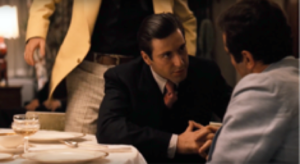 Michael is not as gentle, however, when he arrives in Las Vegas to buy Moe Greene’s casino and offer Johnny Fontaine a new contract. In this scene, Michael clasps his hands as well, except with his thumbs pressed together. Not only is he steadfast in his position, but also he’s confident that no one in the room can “refuse” him nor the strength he flexes. Moe Greene then barges in and argues with Michael over the notion that he can “buy [him] out,” and Fredo defends Moe and questions Michael’s reasoning. Echoing the earlier scene in which his father advised Sonny to “never tell anyone outside the family what [he thinks] again,” Michael warns Fredo never to “take sides with anyone against the family again.”
Michael is not as gentle, however, when he arrives in Las Vegas to buy Moe Greene’s casino and offer Johnny Fontaine a new contract. In this scene, Michael clasps his hands as well, except with his thumbs pressed together. Not only is he steadfast in his position, but also he’s confident that no one in the room can “refuse” him nor the strength he flexes. Moe Greene then barges in and argues with Michael over the notion that he can “buy [him] out,” and Fredo defends Moe and questions Michael’s reasoning. Echoing the earlier scene in which his father advised Sonny to “never tell anyone outside the family what [he thinks] again,” Michael warns Fredo never to “take sides with anyone against the family again.”
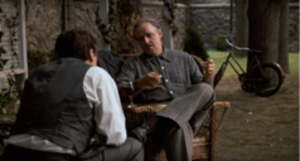 In their final interaction in the film, Michael is already Don of the Family and Vito is “retired.” The viewer can sense a shift in Vito’s demeanor; he is smiling, joking, drinking wine, and sitting with his right leg folded above the other. He is not hunched over, as he had been in many previous scenes. The burden of the Family business has been removed from his shoulders, and he can take it easy, if only for an instant.
In their final interaction in the film, Michael is already Don of the Family and Vito is “retired.” The viewer can sense a shift in Vito’s demeanor; he is smiling, joking, drinking wine, and sitting with his right leg folded above the other. He is not hunched over, as he had been in many previous scenes. The burden of the Family business has been removed from his shoulders, and he can take it easy, if only for an instant.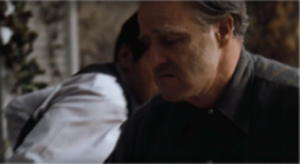 Tellingly, when Vito positions himself in his seat, he obscures the image of Michael. The camera work suggests how succession works in this family: the importance of the patriarch means that there’s no room for others, just the single male head. To be powerful, to be head of the family: this aspiration is tied to Michael becoming singular, with a way of moving his body that—however indebted to his father—is his and his alone.
Tellingly, when Vito positions himself in his seat, he obscures the image of Michael. The camera work suggests how succession works in this family: the importance of the patriarch means that there’s no room for others, just the single male head. To be powerful, to be head of the family: this aspiration is tied to Michael becoming singular, with a way of moving his body that—however indebted to his father—is his and his alone.